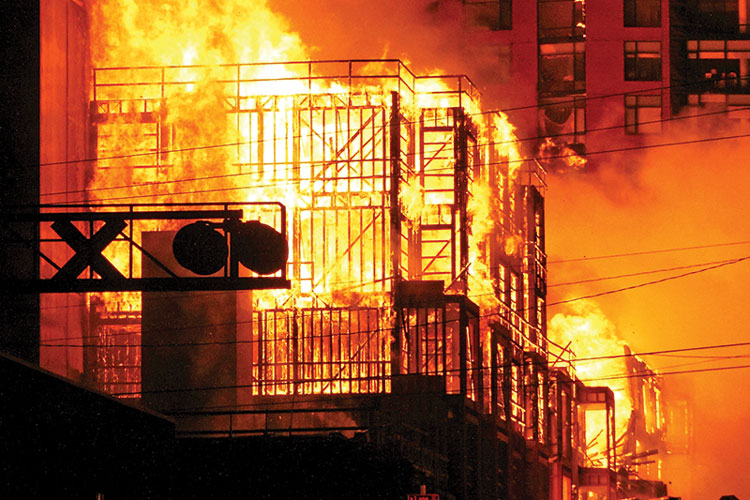
By Stephen J. Corker
On Thursday, March 16, 2017, the Raleigh (NC) Fire Department responded to one of the largest fires in its 105-year history as a career fire department. The Metropolitan – a five-story; block-long and half-block-wide; wood-frame; 274,000-square-foot apartment building still under construction – was burning. It took three hours and 32 fire companies (130 firefighters) to get the fire under control. Several other buildings were damaged by flames, heat, and flying embers.
Designed as a beautiful addition to the Glenwood South area of downtown Raleigh, the 300- × 400-foot structure was a massive sight to behold. Still in the framing stage at the time of the fire, it resembled a never-ending pile of building materials, engineered wood, and construction debris. The stairwell, parking deck, and metal construction machinery were the only noncombustible materials in the complex.
Wood-frame buildings of lightweight construction have become popular in Raleigh and have sparked much discussion in our fire stations. Most firefighters had discussed “when it would happen” and “what we would do.”
Before my current assignment with the Training Division, I had been assigned to the ladder company for this area. We discussed the possibility of a conflagration in these immense wooden structures that were popping up, notably while they were under construction and without fire protection. As we watched these buildings rise from concept to reality, the challenges of water supply, apparatus placement, and accessibility became very apparent. The chain-link fences and strategically parked machinery to deter thieves and unwanted guests made it difficult for access and advancing hose into the construction area and the building. Even the construction equipment was a concern. How would we extricate a trapped victim from machinery, for example, or remove a cardiac patient from a multistory tower crane?
Tower Crane Challenges
One specific scenario we evaluated was the possibility of a tower crane collapse. This type of incident has been happening across the country. Only a few of our discussions, however, considered what would happen in a fire – notably, the metal structure that holds the towering unit would experience duress and likely fail when exposed to high temperatures.
Division Chief John Fanning, who responded to the Metropolitan fire, has researched crane collapses and felt a certain “intuition” to prepare for the worst in his own city. Little did he know that he would be using this knowledge in the coming days!
Some of the characteristics of the tower cranes used in Raleigh include the following:
- They’re designed with counterweights to offset their expected load.
- The operators are usually in the crane cab for 10 to 12 hours per shift.
- They are of metal truss type construction and, like most steel metal, are expected to elongate at approximately 1,000°F.
- When not in operation, they freely rotate when forces, such as wind, are applied to the hoisting arm. This limits stress on the supporting structural members.
Those stationed near these heavy construction areas have been fortunate to learn some of these facts during calls, while preplanning, and from station discussions. However, Raleigh has only a few areas with high-rise buildings. Although the Metropolitan was a mid-rise building, it was in the downtown area where most Raleigh high-rise construction has been taking place.
Most of our city is residential or mid-rise commercial. New construction has started to spread to areas outside of the downtown district in recent years.
The tower crane at the Metropolitan was near the center of the construction site, at a point where it could lift materials to the wood-frame apartments, the concrete parking deck, and the block-constructed stairwell locations.
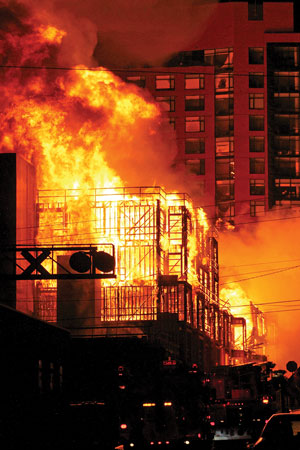 |
| (1) A view from the northwest corner shows the massive flames and the Quorum high-rise in the background. (Photos by Mike Legeros.) |
Building Codes and Fire Protection Measures
The Metropolitan was built to current codes that allow wood-frame construction with the expectations of fire safety requirements on completion of the project or at the time of occupancy. These standards are common across the country and include the following:
- National Fire Protection Association 13 fire suppression system.
- Fire alarm system.
- Noncombustible, fire protected stairwells.
- Fire protecting wall covering, such as gypsum board.
- Standpipes.
- Type 3A fire retardant wood-frame construction for apartments. Parking deck built of Type 2-B construction with three-hour separation (concrete).
Unfortunately, until these fire protection measures are added, the building is highly vulnerable to fire while under construction. The Metropolitan fire occurred prior to the placement of many of these systems. There were no fire stops, gypsum, and suppression/notification systems. Also, the fuel load was at peak at this stage of construction.
A Potential Problem for the Fire Service
Buildings like the Metropolitan pose a higher risk during particular times of their existence. As Fire Department of New York Battalion Chief (Ret.) Jerry Tracy said during the 2017 Fire Department Instructors Conference International, a building like this is vulnerable “when it’s born [the construction stage], it’s sick [the systems are aged or shut down for repair or remodel], and it’s dying” [when the building has been abandoned or is being demolished] – in other words, when the fire protection systems are not working. Firefighters are charged with protecting these buildings, their occupants, and the surrounding exposures at all times. This task becomes much more difficult when conditions are less than ideal.
We have only one option to lessen the impact in a big building fire: reduce heat. But, when a building is vulnerable, the fire gets a head start, and we have no allies to help in the “good fight.” At the Metropolitan, there was an abundance of fuel, oxygen, and heat. The fire grew rapidly after ignition, and there were no building features to slow its pace. This fire has led to discussions about concerns with the building code. Some people suggested that we shouldn’t build these types of structures because of the massive fire load. However, when they’re occupied, the building is protected with proper systems. There are sprinklers above the false ceilings, areas of refuge, protected stairwells, standpipes, and fire walls. When those systems are in place, the building is nearly as safe as a noncombustible building.
The Fire
The Raleigh Fire Department staffs the following operations personnel each day: one division chief, five battalion chiefs, 29 engines, nine ladders, one heavy rescue, one fire investigator, and one platoon deputy fire marshal. There are three platoons that work 24-hour shifts, with five days of “on/off” followed by a four-day break. We prioritize our staffing per equipment unit based on the location, service type, and what support apparatus are in the same station. The equipment that is “priority staffed” necessitates extra personnel above minimum staff for a similar type of equipment. For example, engine companies on the outer edges of the city are staffed with extra personnel because of the extended time of arrival of second or third companies.
Another example is our hazmat stations. The extra personnel are assigned as personnel on hazmat calls or to operate an extra apparatus unit, if needed. Our minimum staffing is five personnel on “rescue,” four personnel for ladders and priority designated engines, and three personnel for the remaining engines. Minimum staffing for each platoon is 141 personnel, which includes the chief officers. On the day of the Metropolitan fire, 145 personnel were on duty.
On Thursday evening, March 16, the weather was typical for a southern spring night: temperatures about 40°F and a light wind. The sky was clear, and the humidity was low. In the days before the fire, winds of 30 miles per hour had blown through the city. These light breezes were a welcome change.
Just before 10:00 p.m., the Raleigh-Wake County Emergency Communications Center received the first report of a fire in the downtown district. Dozens of people were soon dialing 911 as they saw the fire from neighboring high-rise buildings. The first alarm, at 10:03 p.m., was a multifamily alarm that included four engines, two ladders, the rescue, two battalion chiefs, and the platoon deputy fire marshal. Because of the multiple callers, the call was upgraded to a “working fire” while units were still en route. This added the division chief, the mobile air unit, and the fire investigator.
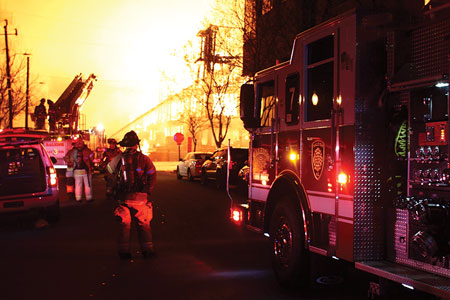 |
| (2) Harrington Street, about 200 feet from Jones Street, with the Quorum just behind Squad 7. This is approximately 100 yards south of the initial command post. |
Second Alarm on Arrival
Engine 13 arrived within a minute of dispatch. Captain Paul Wyatt, the company officer, confirmed a working fire with heavy fire showing from the second floor. He immediately requested a second alarm during his size-up. Two minutes later, he requested a third alarm. Wyatt notified all units that the fire was spreading quickly, that there was no fire protection in place in the burning building, and that exposures were the first priority. As flames spread throughout the open structure, the radiant heat increased. The first-arriving ladder and, later, Engine 13 were repositioned to protect them from damage and to allow for a better position.
Arriving engine and ladder companies began locating their hydrants, and a request was made to increase volume and pressure to the water distribution system of the area. The actual water or pressure increase of this request is not fully known. The Raleigh Water Department redirected as much water as possible and used pump stations to increase pressure. Crews began deploying portable monitors and preparing aerial streams to protect the surrounding exposures.
Battalion Chief A.C. Rich arrived on scene and assumed command from Wyatt. He organized the relocation of apparatus to allow for more large-flow devices to be put in service and directed units to various locations to prepare for exposure protection.
What Rich and the others couldn’t see was a tower crane on the construction site. From their vantage point at ground level on the south side of the Metropolitan, the crane was concealed by the billowing smoke and flames. Fanning, however, had seen the crane above the smoke as he approached on Boylan Avenue. He called on the radio and notified crews of the crane’s presence and its being involved in fire.
Shortly thereafter, the black, smoky thermal updraft of the fire around the crane ignited, surrounding the crane in flames. The fire churning in the smoke looked almost like boiling, billowing tar, Fanning later recalled. The intense heat from the fire also caused glass in the nearby buildings to break.
Protecting Exposures
The Quorum Center, which faced the Metropolitan across Jones Street, was a mixed-use facility of business and residential that stood 15 stories tall. Across Harrington Street was the seven-story Link Apartments. Directly east was the three-story League of Municipalities office building. Other nearby structures included single-story office buildings, several churches, and other commercial facilities. The plume of smoke and embers traveled upward and southeast of the fire. The plume was so dense that it was visible by Doppler weather radar, and burnt materials were found more than 10 miles from downtown. At the scene, on nearby blocks, the embers started fires on rooftops and in grass, bushes, and trash.
As the first fire units arrived, personnel were directed to the Link Apartments and Quorum Center to assist with evacuating residents. Operations in those buildings, which shifted from evacuation and rescue to high-rise fire suppression, were soon under the command of their own chief officers. Three battalion chiefs and three assistant chiefs responded to the Metropolitan at the beginning of the incident. A fourth assistant chief was deployed to the Emergency Operations Center, at the 911 center, to triage calls and help organize additional resources, including companies and mutual-aid units for coverage. Two other battalion chiefs, off site, remained in service and helped with logistics, coverage coordination, and more.
Assistant Chief of Operations Brad Harvey arrived early in the incident and assumed command from Rich, Battalion 3. He, Rich, and Fanning devised a plan to “divide and conquer” the incident. Each of the four sides of the fire building was assigned a chief officer, along with command branches for the Link Apartments, the Quorum Building, and the exposures on the southeast side of the Metropolitan. The expandability of the incident command system proved valuable for the magnitude of this event.
Once the fire building was divided and companies were assigned to coordinate their efforts, the fire was in full bloom. The volume of fire made the notion of water being sprayed from 1,000 to 1,500 gallon-per-minute master streams futile for the intense heat being generated. Exposures were the priority for monitor and aerial streams. Other companies were assigned to extinguish spot fires or roof fires on nearby exposures.
Falling glass from the 15-story Quorum Center led to complete evacuation of the street between the Center and the Metropolitan. However, the flames licked the side of the building and reached to the top of the structure. Even the building sign just below the roof was melted. Windows were broken on the Quorum Center and the Link Apartments. The intense heat entered the rooms and caused furniture to combust. The sprinkler systems in both buildings activated in numerous rooms and prevented the spread of fire on multiple floors.
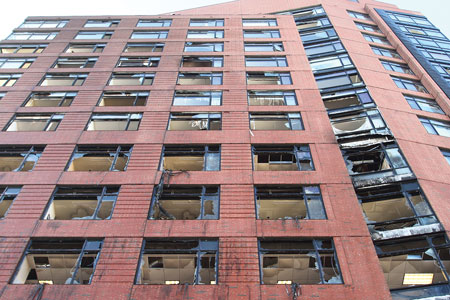 |
| (3) A view from Jones Street looking up at the Quorum the day after the fire. Glass from the high-rise had to be removed before the street was opened. |
The Crane Collapse
At 10:19 p.m., 16 minutes after the first engine’s arrival, the tower crane collapsed. Companies had been assigned or reassigned to locations around the fireground. On Harrington Street, on the west side of the fire building, Ladder 2 had backed up the street to take cover behind the Metropolitan’s concrete parking deck. “The crane is coming down!” the radios on scene were screaming.
The updraft and light wind conditions had already rotated the free spinning, working arm of the tower crane. As the intense heat weakened the steel support structure, the counterweight became more than the fire-weakened metal could bear. First, the vertical structure shifted, and the counterweight pulled the hoist arm up into the air like a medieval catapult. With a crash, it fell onto the west side of the burning building; onto the street; and across a small, single-story industrial building.
It also snapped a series of power lines, causing progressive transformer explosions and a power outage in the immediate area. The collapse narrowly missed the just-relocated Ladder 2 and its crew and the personnel on Rescue 1. They had just walked down that street on their way to the command post. For a couple of terrifying minutes, the status of both Ladder 2 and Rescue 1 was unknown. Radio silence was ordered, and the accountability officer verified that all personnel were safe.
Crews continued to work around the two-block radius, extinguishing spot fires and flowing copious amounts of water until the fire began to run out of fuel. The lightweight construction produced immense heat and a rapidly burning fire. Within a couple of hours, the Metropolitan was entirely consumed. Only the concrete parking deck and stairwell structures remained standing. The fire was marked under control at 1:10 a.m.
Lessons Learned
The Metropolitan fire presented challenges that even 30-year veteran members had never seen. The discussions that followed in the weeks since the conflagration have resulted in training on tactics that were not commonly practiced. Although a very proactive department relative to preparation and adequate staffing on dispatch, the Raleigh Fire Department was presented with a significant challenge by a fire of this magnitude. Among the points we have discussed since the fire are the following:
- “Go big; go early!” Chief John McGrath made the statement during a news conference after the fire. It represents how we front-load our responses to reported structure fires. That large complement of units is further increased for a reported high-rise fire. Sending more units than may be necessary allows more people to be positioned earlier to more effectively contain or confine a fire. Although this didn’t stop the fire at the Metropolitan, it put resources on scene faster for exposure protection.
- Call for alarms early. Our first-arriving officers are allowed and encouraged to call for additional resources. Wyatt’s recognition of this need for more personnel and equipment is another example of getting units to the scene as quickly as possible.
- Big fire, big water. But, what if you aren’t attempting to put out the fire? Big exposures also need big water. The immense fuel load of the Metropolitan produced 200-foot-high flames that were fed by the wind generated by the fire. Exposure protection on three sides, as well as fires on and inside those buildings, necessitated a lot of water. If your fire needs big water, your exposures need big water. Actually, the dispatcher called for an increased flow to the hydrant system before the incident commander (IC) requested it.
- Master streams. Aerial streams, prepiped deluge guns, and portable monitors are musts for fires of this type. Like many city departments, Raleigh has a traditional preference of interior attacks. We have made positive changes over the years to establish water supply on arrival and add higher-flow nozzles on handlines. We train on deploying portable monitors and aerial streams, but the prepiped deluge is often overlooked. As the saying goes, “out of sight, out of mind.” Would a deck gun have made a big difference at the Metropolitan? We don’t know, but it’s another tool that, if available, should be part of your “big fire toolbox.” It may knock down the fire just long enough for you to get your attack lines in place. Again, big fire, big water.
- Sprinkler systems. If the sprinkler system is installed in a building under construction, consider using the system. Try to supply the system; if the sprinklers activate but do not reach your desired target, adjust your plan accordingly. In the exposure building, we used crews with high-rise packs to supplement what the sprinklers did not hit or, in some cases, we just moved burning pieces of furniture under the flowing heads.
- Get a little help from your friends. Mutual aid, automatic or otherwise, is one of the most valuable commodities during large-scale incidents. The availability of mutual-aid departments to provide coverage for the city residents kept the machine running. We must all work to develop these relationships and train with our neighbors to share skills and tactics.
- Quarantine. Work to get enough space around the scene. This fire led to multiple spot fires for several blocks. This necessitated positioning crews in other locations around the fire building and immediate exposures. The ember plume carried debris for miles.
- Value of leadership. The opportunity to lead is everywhere during a large incident. The personnel who set a calming tone from the “first five minutes” to a sudden benchmark, like a crane collapse, to the days of investigation that followed the event gave formal and informal leaders a chance to show their talent. Many of these folks had no desire to be in the spotlight, but their number was called. When that opportunity arrives for you, will you be prepared to handle the situation?
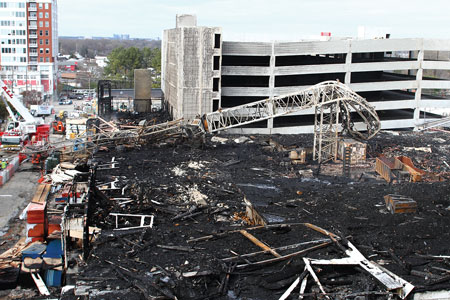 |
| (4) The twisted remains of a construction crane were visible the morning after; the crane had collapsed across Harrington Street and onto an industrial building. |
Dispatching and Radio Procedures
We also learned valuable lessons about dispatching and radio procedures. On this call, a veteran telecommunicator handled call-taking and dispatching duties. His experience led to such positive outcomes as the following:
- The dispatching of units to the high-rise. The standard call information would not have clearly suggested the need.
- A request for a pressure boost for the hydrant system before the IC called for it.
- An on-call assistant who coordinated staff and operations.
- The triaging of emergency calls received during the fire.
- Handling of the complex radio traffic for multiple alarms and of the radio channels.
We also recognized the need for radio consistency. Small things make a big impact when an incident of this magnitude occurs. For example, the language used to describe fire behavior or apparatus placement must be uniform and understood. Also, when a group of radio channels is requested, those channels should be close together – if possible, within the same radio “bank” such as Tac 18, 19, 20, 21, 22. You should not have to press additional buttons on portable radios to change banks.
Planning for Major Incidents
In addition to the above lessons learned, the Raleigh Fire Department has been reviewing its major incident planning since the Metropolitan fire. Any fire department, regardless of size, must have a plan for large-scale incidents. We have an All Hazards Plan, a living and adaptable layout of how to handle any major event. The scope includes components for coverage, calling back personnel, logistics responsibilities, and activating the Emergency Operations Center.
Although this plan is practiced annually, this event showed us a few pieces that could be shored up:
- Efficient callback procedure is paramount. It is recommended that we use an automated system for notifications to off-duty personnel and include where they should report on scene. This allows one or two people to handle the callback.
- Incidents lasting 24 or more hours should have logistics and planning sections. They are not normally areas of concern at a structure fire, but they are needed for incidents that have components such as extensive rehab efforts and multiple operational periods.
- Off-duty personnel should refrain from responding to the scene. First, rest is part of the operational period system. The incoming platoon needs its personnel to be rested and ready to work. Second, off-duty help, while well-intentioned, adds to the complexity of accountability.
- A public information officer should be appointed. This role should not be filled by personnel who have been engaged in fireground activities – for example, a sleep-deprived chief officer who has been on scene for 14 hours. Although it may be necessary at times, avoid appointing nondepartment personnel who do not have a knowledge of firefighting.
The Metropolitan fire reinforces the importance of preserving history. Every fire department has stories that should be told. Members must be willing to show pride in their accomplishments while looking in the mirror to recognize weaknesses. Lessons must be learned.
This glimpse into the night of March 16, 2017, is intended to praise the hard work of the Raleigh Fire Department and to recognize areas in which improvements could be made. The pride and ownership of our actions, good or bad, are the core of the fire service’s good reputation. Our best leaders learn from mistakes on the fireground and transform their tactics in such ways as were successful at the Metropolitan fire.
STEPHEN J. CORKER has been a member of the fire service for 18 years and is a full-time captain in the Raleigh (NC) Fire Department, where he has been a member since 2002. He is serving as the career development coordinator in the Training Division. He has several instructor credentials, including those by the National Fire Academy in leadership, fire officer, driver operator, and live fire.
Toothpick Construction: Enough is Enough, Part 1
Toothpick Construction: Enough is Enough, Part 2
Listen: Firefighter Radio Documents Raleigh Historic Fire
Fire Engineering Archives

